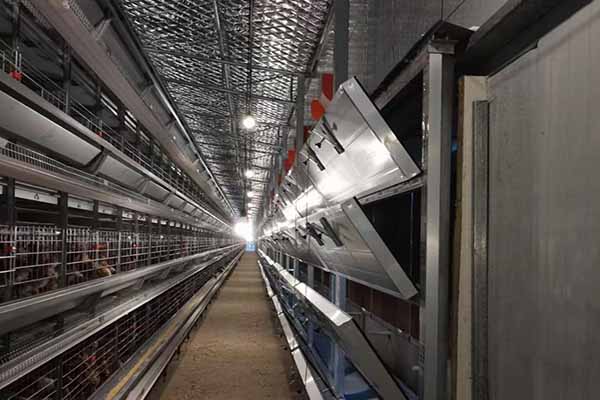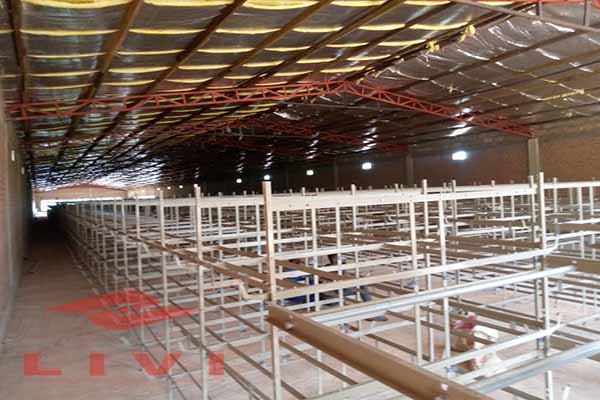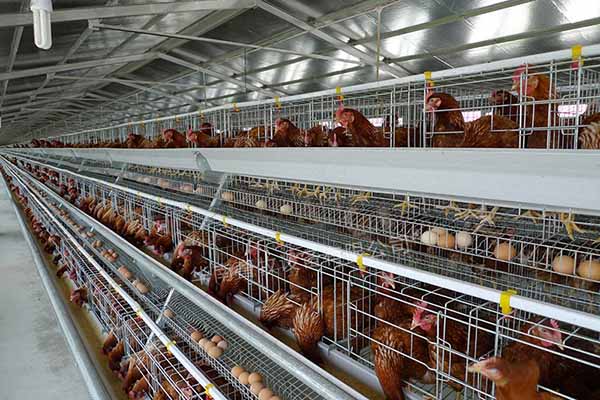Large-scale Chicken Farming Cages for 60000 Birds: Design, Efficiency, and Management
Time : 2025-06-29
Large-scale chicken farming has become a cornerstone of the poultry industry, especially with the demand for poultry products on the rise globally. To cater to this demand, modern chicken farming facilities are equipped with state-of-the-art technology and design. One such key component is the use of large-scale chicken farming cages designed to accommodate up to 60,000 birds. This article delves into the design, efficiency, and management aspects of these cages, ensuring that poultry farmers can make informed decisions for their operations.

Design Considerations for Large-scale Chicken Farming Cages
Designing large-scale chicken farming cages for 60,000 birds requires careful planning and consideration of several key factors.
Space Allocation
The primary concern in designing such cages is the allocation of space for each bird. Industry standards suggest that each bird should have approximately 0.3 to 0.5 square meters of space. This ensures that birds have enough room to move around, reducing stress and the risk of diseases. In a cage designed for 60,000 birds, the dimensions of the cage would need to be considerable, potentially ranging from 50 meters in length to 10 meters in width, depending on the depth of the cage.
Material Selection
The choice of material for the construction of these cages is crucial. Steel is a common choice due to its durability and resistance to corrosion. The material should be galvanized to protect against rust and withstand the harsh conditions of a poultry farm. Additionally, the surface should be smooth to prevent injury to the birds and facilitate easy cleaning.
Airflow and Ventilation
Proper airflow and ventilation are essential for maintaining a healthy environment within the cage. The design should incorporate a system that ensures adequate fresh air supply and exhaust, preventing the buildup of ammonia and other harmful gases. Ventilation should be controlled to maintain optimal temperature and humidity levels, which can vary depending on the season and geographical location of the farm.
Feed and Water Distribution
Efficient feed and water distribution systems are integral to the success of large-scale chicken farming. The design should include automated feeders and waterers that can serve the entire flock without manual intervention. This not only saves time and labor but also ensures that each bird receives a consistent and balanced diet.
Efficiency in Large-scale Chicken Farming Cages
Efficiency in large-scale chicken farming cages is achieved through a combination of advanced design features and smart technology integration.
Automated Systems
Automation plays a critical role in the efficient management of large-scale chicken farming cages. Automated systems can monitor and adjust parameters such as temperature, humidity, and air quality in real-time. They can also track bird health and performance, providing valuable data for decision-making and optimization.
Environmental Control
Environmental control systems are designed to mimic natural conditions as closely as possible, which can lead to improved bird health and productivity. These systems can adjust the lighting, temperature, and ventilation to ensure that birds are in an optimal environment for growth and laying.
Health Management
Early detection and management of diseases are crucial in large-scale chicken farming. Advanced monitoring systems can detect early signs of illness in birds, allowing for prompt treatment and minimizing the risk of an outbreak. These systems can also track the movement of birds within the cage to prevent the spread of disease.
Management Practices for Large-scale Chicken Farming Cages
Effective management practices are essential to maintain the health and productivity of the flock in large-scale chicken farming cages.
Regular Maintenance
Regular maintenance of the cages and associated systems is crucial for their proper functioning. This includes cleaning the cages, checking the waterers, and ensuring that feeders are functioning correctly. Regular inspections can help identify and address any issues before they become significant problems.
Employee Training
<p-Trained staff are essential for the efficient operation of large-scale chicken farming cages. Employees should be knowledgeable about the farm's systems and procedures, as well as the health and behavior  of the birds. Regular training sessions can help ensure that staff are up-to-date with the latest practices and technologies.
of the birds. Regular training sessions can help ensure that staff are up-to-date with the latest practices and technologies.
Data Analysis
<p-Collected data from automated systems and other monitoring tools should be regularly analyzed to identify trends and areas for improvement. This data-driven approach can lead to more informed decision-making and continuous improvement in the farm's performance.
Large-scale chicken farming cag es designed for 60,000 birds represent a significant investment in both time and resources. However, with careful design, efficient systems, and effective management, these cages can provide a sustainable and profitable operation for poultry farmers.
es designed for 60,000 birds represent a significant investment in both time and resources. However, with careful design, efficient systems, and effective management, these cages can provide a sustainable and profitable operation for poultry farmers.











